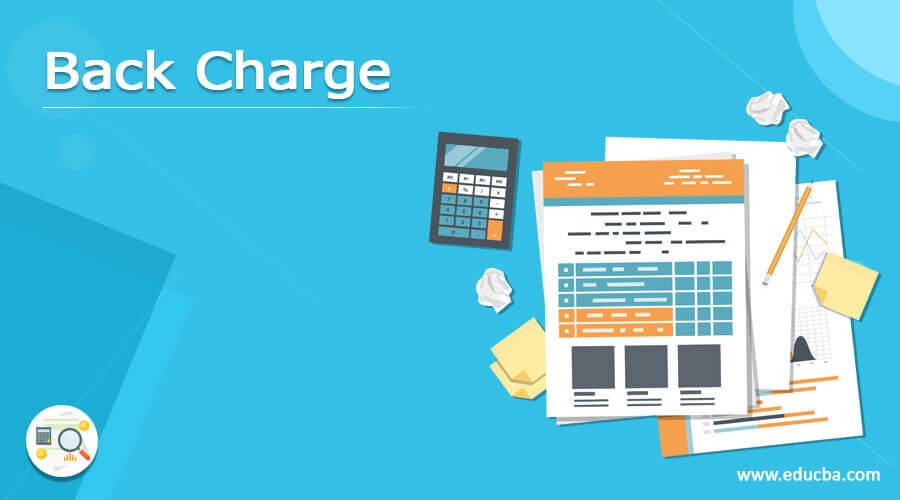Updated July 13, 2023
What is a Back Charge?
Back Charge is an additional bill raised concerning work done previously due to some element of billing missed in the previous billing cycle or any adjustment, late fee, or additional charges.
It is mostly used in industries where transactions are prone to errors or mistakes in day-to-day business affairs. The company applies the charge either on a real-time basis or can apply it later down the billing cycle. The major back-charge industries are banks, credit card companies, construction companies, manufacturing, wholesale, retail, etc. It is best to avoid back charges and do the billing rightly to the customer, as it may bring up recoverability issues. It so happens that sometimes back-charge receivables are tough to recover.
Example of Back Charge
ABC Stores is a wholesale seller of grocery products. Mr. X is a regular customer of ABC Stores who runs a retail shop. He purchases condiments from the store on a monthly basis; the products are directly delivered to Mr. X along with the bill. In the month of December, due to the year-end clearance sale, the billing of some products was missed to Mr. X, but the goods were delivered as usual. So due to this, in January, the owner of ABC Stores made the December bill as a back charge and added up to the January bill.
Z Corporation is a construction company; considering the nature of the business, they have running account bills with their sub-contractors. Most of the time, there is under charge or overcharge for the work done. So it is more like a customary practice in this industry, and settlement happens accordingly.
KBC Bank has decided to increase the credit card fee from September, but the same is not informed to customers till November, and the increased charges are sent as a back charge along with interest charges to the customers. This could have been done in real-time and informed to the customers before, so it doesn’t come to customers unexpectedly. It looks like a purposeful delay to charge the interest on late payment of an increased fee.
But it is best to raise the bill then and there to avoid confusion and other legal issues. If any billing is missed, informing the customers before charging the back charge is best.
Keys to Success with Back Charge
Bank charges can become feasible with the right communication and proper documentation. The company has to communicate it to the customers and business partners so that it doesn’t surprise or shock them. In the same way, the back charge should be backed by proper documentation so there cannot be any conflict or disagreement on the charges later on.
If the back charge system is aligned and agreed upon between the parties, dealing with the back charge billing could be easier. However, miscommunication or gaps in communication and lack of documentation will lead to disagreements, and recoverability of back charge receivables becomes challenging.
Significance
The back charge billed is part of the company/business accounts receivables. To have the right balance sheet, the receivables in the books should match the payables of customer books. Their receivables are like regular receivables as the company that renders service or delivers goods needs to receive the money from the customers that are missed bills in the original billing. Therefore, any disagreement or non-recoverability of these receivables is like bad debts and their loss to the business.
Advantages
- It helps to recover the money in case of any incorrect billing if the originally billed amount is lesser than the revised bill or to correct any mistakes in the billing. It helps business owners recover money from erroneously missed customers.
- If the original bills are not cleared on time, it will allow the customers/ business partners to clear the dues. This mechanism gives one more chance to the customers and helps in avoiding disputes on non-payment on time.
- It helps correctly account for the accounts receivables and accounts payables on the books of both parties to the transaction. Any accounting miss could impact the business’s profitability and the presentation of the financial statements. It could lead to misrepresentation of the Income statement and Balance Sheet.
Disadvantages
- Billing rightly on the first time is important as sometimes a back charge won’t be accepted if the back charge bill is raised late.
- Recovering the back charge billing receivables is tough due to disputes, disagreements, or customers refusing to pay the amount. However, it could be bad receivables and affect profitability if not recovered.
- Sometimes it can lead to legal issues and disrupt the relationship with customers.
Conclusion
The prime purpose of the back charge is to bill the customers for the services rendered or goods delivered but failed or missed to bill at the right billing cycle. It could be due to multiple reasons, missed bills, incorrect charges, additional charges, late payment fees, etc. It is billed to the customers to recover the money for the services or goods delivered. Therefore, it is always better to avoid back charges as any additional charge could be an unexpected factor to the customers. It is also very tough to recover the back charge receivables if the customers don’t agree or fail to pay.
Recommended Articles
This is a guide to Back Charge. Here we also discuss the definitions, examples, and keys to success with the advantages and disadvantages of Back Charge. You may also have a look at the following articles to learn more –




